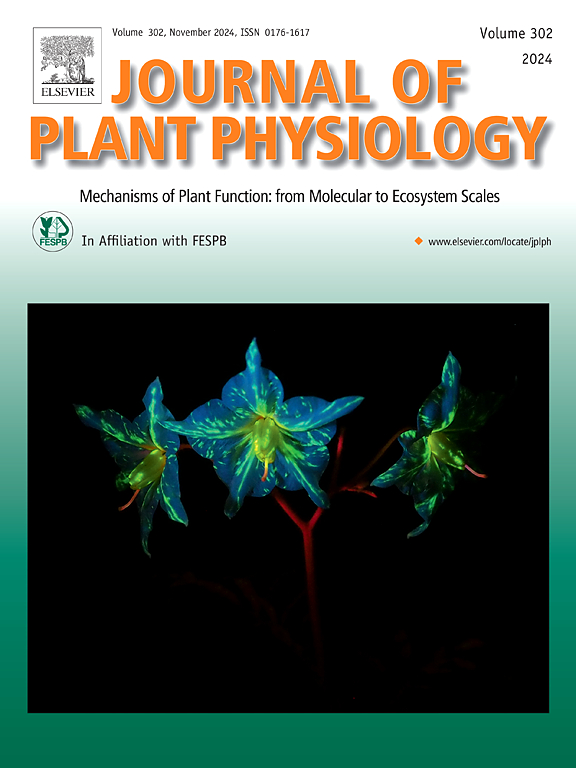拟南芥硝酸盐调控1通过调控离子稳态和GA代谢负向调节盐胁迫的耐受性。
IF 4.1
3区 生物学
Q1 PLANT SCIENCES
引用次数: 0
摘要
以前的研究已经将植物的硝酸盐吸收调节与盐胁迫耐受性联系起来。在此基础上,我们的研究旨在研究ANR1基因在盐胁迫反应中的作用,该基因参与硝酸盐的感知和信号传导,利用ANR1敲除植物。结果表明,与Col-0相比,anr1植株具有更好的根长、生物量和叶绿素含量,对盐胁迫的耐受性更好。与对照相比,盐胁迫下anr1植株活性氧(ROS)积累较少,丙二醛(MDA)水平增幅较小。它们还保持较高的硝酸盐和花青素含量和较低的Na+/K+比,表明生理稳定性增强。基于它们在盐胁迫下的良好生长,我们进一步探索了赤霉素(GA)的作用,这是一种调节植物生长的激素。正常情况下,GA信号在盐胁迫下受到抑制。然而,anr1植株积累了较低水平的DELLA蛋白,如GAI,并且用GA生物合成抑制剂多氯布唑(PBZ)处理后,anr1植株的耐盐性降低到Col-0水平,这表明在逆境适应中anr1与GA代谢之间存在联系。虽然ANR1在发芽期胁迫反应中的作用已经被注意到,但本研究强调了它在幼苗期的功能,特别是通过与GA相关的盐胁迫耐受性调节。这些发现表明,ANR1是一个有希望的基因编辑靶标,可以增强作物在盐水条件下的抗逆性。本文章由计算机程序翻译,如有差异,请以英文原文为准。
ARABIDOPSIS NITRATE REGULATED 1 negatively regulates the tolerance of salt stress by controlling ion homeostasis and GA metabolism
Previous studies have linked nitrate uptake regulation in plants to salt stress tolerance. Building on this, our study aimed to investigate the role of the ANR1 gene, involved in nitrate sensing and signaling, in salt stress response using anr1 knock-down plants. Our results showed that anr1 plants exhibited improved tolerance to salt stress compared to Col-0, with better root length, biomass, and chlorophyll content. Under salt stress, anr1 plants accumulated less reactive oxygen species (ROS) and showed smaller increment in malondialdehyde (MDA) levels relative to control conditions. They also maintained higher nitrate and anthocyanin contents and a lower Na+/K+ ratio, indicating enhanced physiological stability. Based on their superior growth under salt stress, we further explored the role of gibberellin (GA), a hormone regulating plant growth. Normally, GA signaling is suppressed under salt stress. However, anr1 plants accumulated lower levels of DELLA proteins such as GAI, and treatment with paclobutrazol (PBZ), a GA biosynthesis inhibitor, reduced the salt tolerance of anr1 plants to Col-0 levels, suggesting that a link between ANR1 and GA metabolism in stress adaptation. While ANR1's role in germination-stage stress response has been noted before, this study highlights its function during the seedling stage, particularly in modulating salt stress tolerance through in association with GA. These findings indicate that ANR1 is a promising target for gene editing to enhance crop resilience under saline conditions.
求助全文
通过发布文献求助,成功后即可免费获取论文全文。
去求助
来源期刊

Journal of plant physiology
生物-植物科学
CiteScore
7.20
自引率
4.70%
发文量
196
审稿时长
32 days
期刊介绍:
The Journal of Plant Physiology is a broad-spectrum journal that welcomes high-quality submissions in all major areas of plant physiology, including plant biochemistry, functional biotechnology, computational and synthetic plant biology, growth and development, photosynthesis and respiration, transport and translocation, plant-microbe interactions, biotic and abiotic stress. Studies are welcome at all levels of integration ranging from molecules and cells to organisms and their environments and are expected to use state-of-the-art methodologies. Pure gene expression studies are not within the focus of our journal. To be considered for publication, papers must significantly contribute to the mechanistic understanding of physiological processes, and not be merely descriptive, or confirmatory of previous results. We encourage the submission of papers that explore the physiology of non-model as well as accepted model species and those that bridge basic and applied research. For instance, studies on agricultural plants that show new physiological mechanisms to improve agricultural efficiency are welcome. Studies performed under uncontrolled situations (e.g. field conditions) not providing mechanistic insight will not be considered for publication.
The Journal of Plant Physiology publishes several types of articles: Original Research Articles, Reviews, Perspectives Articles, and Short Communications. Reviews and Perspectives will be solicited by the Editors; unsolicited reviews are also welcome but only from authors with a strong track record in the field of the review. Original research papers comprise the majority of published contributions.
 求助内容:
求助内容: 应助结果提醒方式:
应助结果提醒方式:


